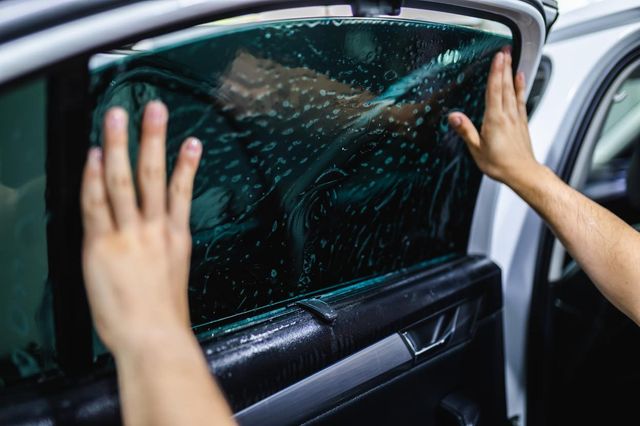Leading Reasons to Choose Professional Vehicle Window Tinting Providers
Leading Reasons to Choose Professional Vehicle Window Tinting Providers
Blog Article
Home Window Tinting Regulations and Guidelines: What You Need to Know Prior To Tinting Your Automobile
Prior to waging home window tinting for your vehicle, it is necessary to familiarize yourself with the varied legislations and guidelines that control this technique throughout different states. These policies dictate the allowable degrees of color darkness, frequently gauged by noticeable light transmission (VLT) percentages, and include particular terms for front windshields aimed at guaranteeing roadway safety. In addition, certain territories might use clinical exceptions for individuals with qualifying conditions. Recognizing these intricacies can conserve you from possible legal ramifications, but what are the details guidelines in your state?
Overview of Home Window Tinting Regulations
Window tinting regulations are frequently subject to variation across various jurisdictions, showing regional guidelines and safety considerations. These regulations dictate the permissible degrees of color darkness and reflectiveness on vehicle home windows, guaranteeing that chauffeurs maintain ample exposure while also shielding versus damaging UV rays and heat.
Many policies classify home window tinting based upon the Visible Light Transmission (VLT) percentage, which shows the quantity of light that can go through the home window. Usually, reduced VLT percents symbolize darker tints. Laws usually separate between the front, side, and back windows, with stricter constraints related to the front windscreen to improve security for both the motorist and various other roadway users.
Conformity with home window tinting regulations is vital, as violations can result in fines, obligatory removal of the tint, and prospective increases in insurance coverage premiums. It is crucial for automobile proprietors to acquaint themselves with local laws prior to proceeding with window tinting installments.
State-by-State Tint Regulations
Recognizing the particular home window tinting guidelines in each state is important for lorry proprietors seeking to follow the law. Each state in the united state has developed its own collection of guidelines governing window tinting, which can vary dramatically. These guidelines frequently determine the permitted degrees of color darkness, the kinds of windows that can be tinted, and any type of clinical exceptions that might use.
For instance, states like California have stringent constraints on tint darkness for front home windows, while others, such as New Mexico, might permit darker tints. In addition, certain states mandate details exposure portions for numerous windows, consisting of the windshield, front side home windows, and rear windows. It is critical for car owners to acquaint themselves with their state's legislations to avoid prospective penalties or fines.
In addition, some states might need an accreditation sticker to be put on colored windows, suggesting conformity with state legislations. Failure to abide by these laws not just risks lawful repercussions yet can also influence safety and exposure while driving. Automobile owners should perform thorough research study or get in touch with regional authorities to make certain full understanding and compliance with state-by-state tint policies.
Allowed Color Degrees and Types
Lots of automobile owners may be shocked to find out that permitted color degrees and types differ widely across different states. Each state has established its own guidelines top article relating to the permitted darkness and reflectivity of window tint, usually gauged by Visible Light Transmission (VLT) percents. VLT describes the amount of light that can pass through the colored home windows; thus, a reduced portion shows a darker tint.

Furthermore, the sorts of color products permitted can vary, with some states forbiding mirror-like or metal coatings. It is vital for vehicle owners to acquaint themselves with their state's details laws to ensure compliance. Non-compliance can cause penalties, necessary elimination of the tint, or other legal repercussions, making it crucial to understand these regulations prior to waging installation.
Medical Exceptions for Tinting
While not all states supply allowances for clinical exemptions relating to home window tinting, those that do acknowledge the requirement for certain individuals to improve exposure and comfort due to clinical conditions. Numerous medical conditions, such as lupus, skin cancer cells, and particular eye problems, can provide people particularly conscious sunlight. Subsequently, these individuals might call for darker colors to secure themselves from harmful UV rays and glow.

It is very important to note that despite having a clinical exemption, there may still be constraints on the level of tint allowed. Conformity with state legislations makes sure that individuals are both secured and within legal restrictions. Those considering medical More Bonuses exemptions must contact their neighborhood Department of Motor Cars or equal authority to understand the procedures and demands necessary to make an application for an exception efficiently.
Fines for Non-Compliance
Falling short to conform with window tinting regulations can cause significant penalties, which differ by state. Police are empowered to provide citations for cars that do not stick to the defined tinting policies. Check Out Your URL These charges generally consist of fines, which can vary from modest amounts to several hundred dollars, relying on the severity of the offense and the state in concern.
In some territories, repeated offenses may result in intensifying fines or extra penalties, such as obligatory court appearances. Additionally, non-compliance might require the removal of unlawful tinting, commonly at the owner's cost. In severe instances, habitual wrongdoers might face suspension of their lorry enrollment till conformity is attained.
In addition, insurance policy implications may develop from getting numerous citations for home window color offenses. Insurance providers might view such infractions as an indication of riskier behavior, potentially bring about boosted costs or trouble in coverage.
To avoid these charges, it is important for vehicle proprietors to acquaint themselves with their local window tinting laws and guarantee that their lorry complies (Window Tinting). This aggressive technique not just stays clear of legal implications but additionally advertises road security
Verdict

Many guidelines identify home window tinting based on the Visible Light Transmission (VLT) percent, which suggests the amount of light that can pass via the home window. Conformity with home window tinting laws is crucial, as offenses can result in penalties, compulsory elimination of the color, and prospective increases in insurance policy premiums.Comprehending the particular window tinting regulations in each state is important for automobile owners seeking to abide with the legislation. These regulations usually determine the allowable levels of tint darkness, the types of windows that can be tinted, and any kind of clinical exceptions that might apply.
For instance, states like California have rigid constraints on tint darkness for front windows, while others, such as New Mexico, might enable darker tints.
Report this page